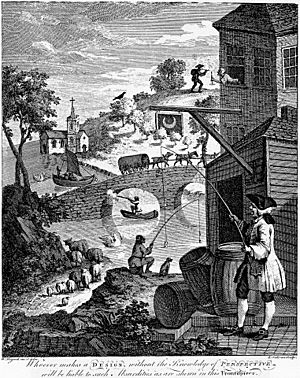Perspective (graphical) facts for kids

In graphic arts, perspective is how artists make a flat picture look like a real, three-dimensional scene. It's about showing how objects appear to change in size and shape based on their angle and distance from the person looking at the artwork. For example, objects that are far away are drawn smaller. This helps create the feeling of depth on a flat surface.
Artists also use a trick called foreshortening. This means they draw parts of an object shorter than they really are. This makes the object look like it's coming towards you or going away from you. It helps create the illusion of three dimensions on a flat canvas.
In landscape paintings, you often see a horizon line. This line shows where the sky meets the land or sea far away. Objects near this line look very small because they are so far off in the distance. Changing where this horizon line is in a painting changes your view. For example, if the horizon is low, it's like you're looking up from the ground. If it's high, it's like you're looking down from a high place.
Understanding Perspective in Art

Perspective works by imagining light rays traveling from a scene to your eye. Think of it like looking through a clear window. If you painted exactly what you saw onto that windowpane, and then stood in the same spot, the painting would look just like the real scene. Each object you paint is a smaller, flat version of the real object on the other side of your imaginary window. This method helps artists create a realistic sense of depth and space in their artwork.
Images for kids
-
A painting from the Song Dynasty (12th century) showing a mill. It uses a type of perspective called oblique projection.
-
The floor tiles in Lorenzetti's Annunciation (1344) show an early understanding of how perspective works.
-
Masolino da Panicale's St. Peter Healing a Cripple and the Raising of Tabitha (c. 1423) is one of the first artworks to use a consistent vanishing point.
-
Melozzo da Forlì used upward foreshortening in his frescoes to make figures look realistic from below.
-
Pietro Perugino's use of perspective in Delivery of the Keys (1482), a fresco in the Sistine Chapel.
-
Satire on False Perspective by William Hogarth, 1753. This artwork humorously shows common mistakes in perspective.
See also
 In Spanish: Perspectiva para niños
In Spanish: Perspectiva para niños












